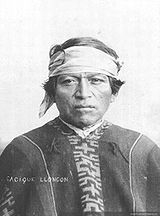
Mapuche
Overview
Indigenous peoples of the Americas
The indigenous peoples of the Americas are the pre-Columbian inhabitants of North and South America, their descendants and other ethnic groups who are identified with those peoples. Indigenous peoples are known in Canada as Aboriginal peoples, and in the United States as Native Americans...
inhabitants of south-central Chile
Chile
Chile ,officially the Republic of Chile , is a country in South America occupying a long, narrow coastal strip between the Andes mountains to the east and the Pacific Ocean to the west. It borders Peru to the north, Bolivia to the northeast, Argentina to the east, and the Drake Passage in the far...
and southwestern Argentina
Argentina
Argentina , officially the Argentine Republic , is the second largest country in South America by land area, after Brazil. It is constituted as a federation of 23 provinces and an autonomous city, Buenos Aires...
. They constitute a wide-ranging ethnicity composed of various groups who shared a common social, religious and economic structure, as well as a common linguistic heritage. Their influence extended between the Aconcagua River
Aconcagua River
For other uses, see Aconcagua .The Aconcagua River is a river in Chile that rises from the joint of two minor tributary rivers at above sea level in the Andes, Juncal river from the east and Blanco river from the south east...
and Chiloé Archipelago
Chiloé Archipelago
Chiloé Archipelago consists of several islands lying off the coast of Chile. It is separated from mainland Chile by Chacao Channel in the north, the Sea of Chiloé in the east and Gulf of Corcovado to the southeast. All of the archipelago except Desertores Islands, which are part of Palena...
and later eastward to the Argentine pampa
Pampa
The Pampas are the fertile South American lowlands, covering more than , that include the Argentine provinces of Buenos Aires, La Pampa, Santa Fe, Entre Ríos and Córdoba, most of Uruguay, and the southernmost Brazilian State, Rio Grande do Sul...
. The Mapuche make up about 4% of the Chilean population, and are particularly concentrated in Araucanía Region
Araucanía Region
The IX Araucanía Region is one of Chile's 15 first order administrative divisions and comprises two provinces: Malleco in the north and Cautín in the south....
and due to emigration in Santiago
Santiago, Chile
Santiago , also known as Santiago de Chile, is the capital and largest city of Chile, and the center of its largest conurbation . It is located in the country's central valley, at an elevation of above mean sea level...
.
The term Mapuche can refer to the whole group of Picunche
Picunche
The Picunche , also referred to as picones by the Spanish, were a mapudungun speaking Chilean people living to the north of the Mapuches or Araucanians and south of the Choapa River and the Diaguitas...
s (people of the north), Huilliche
Huilliche
The Huilliche is an ethnic group of Chile, belonging to the Mapuche culture. They live in mountain valleys in an area south of Toltén River and on Chiloé Archipelago...
s (people of the South) and Moluche or Nguluche
Moluche
Moluche or Nguluche is a dialect of the Mapuche language Mapudungun that is also the ethnic description of the Mapuche peoples speaking that language. At the beginning of the Conquest of Chile by the Spanish Empire the Moluche lived in what came to be known as Araucanía...
from Araucanía, or exclusively to the Moluche or Nguluche from Araucanía.
Unanswered Questions

